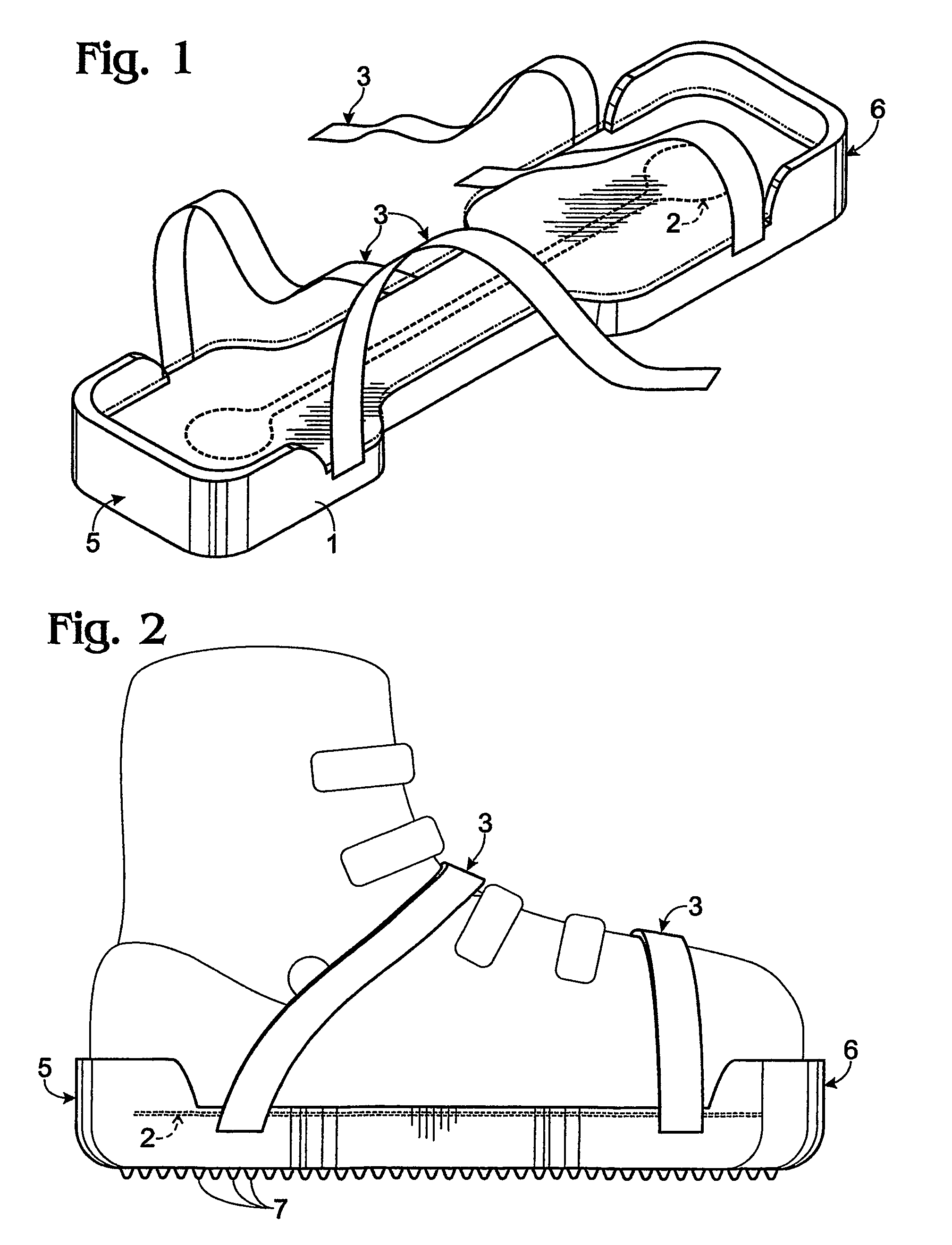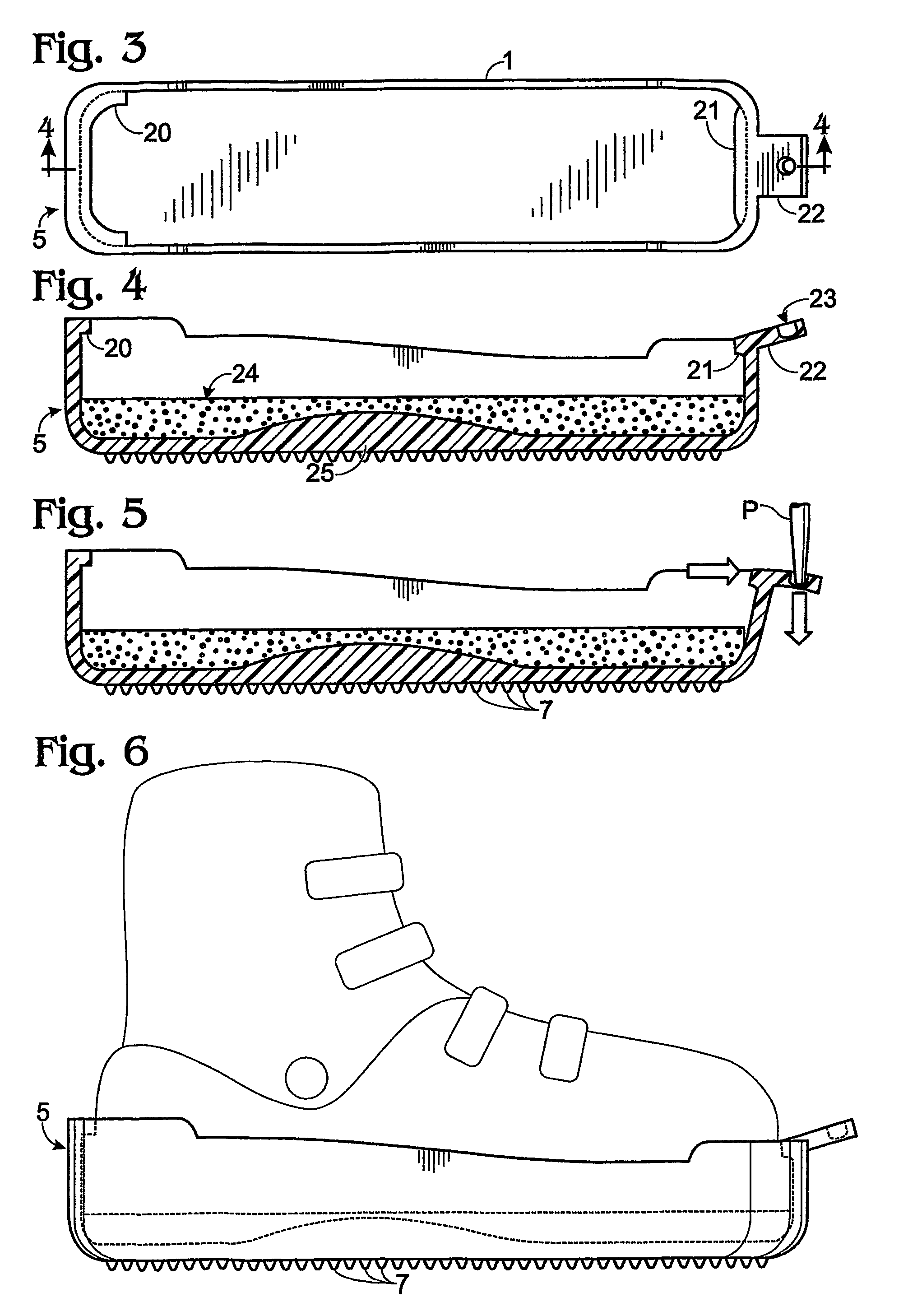Apparatus facilitating walking in ski boots
a technology for ski boots and accessories, applied in the field of ski boot accessories and devices, can solve the problems of inability to meet the basic mechanics of walking, inability to walk, and inability to walk, so as to save production costs and minimize additional weight
- Summary
- Abstract
- Description
- Claims
- Application Information
AI Technical Summary
Benefits of technology
Problems solved by technology
Method used
Image
Examples
first embodiment
[0051]Referring particularly to the drawings, FIG. 1 shows the invented apparatus, the simplest configuration of the invention. The apparatus comprises of five basic pieces: one springy, compression footbed, 1, an optional, encapsulated lengthwise, rigid stringer, 2, an optional, slippery, footbed-covering film, bootstraps, 3, for attaching to the ski boot, and tread covering the bottom of the footbed (as shown in FIG. 2) for traction.
[0052]The exact construction of the footbed can be varied, and should follow manufacturing constraints. For descriptive purposes and not to imply that the footbed must comprise of only a single piece, the footbed is shown in FIG. 1 as a one piece, relatively flat, elongated rectangular piece, and with rounded corners and walls that curve up over the front and rear of the ski boot, just as the sole of a shoe or the sole of a boot curves up, covering the shoe or boot material toe and heel.
[0053]As mentioned, on each end of the footbed, where the heel and...
third embodiment
[0072]Alternatively, if the attachment of the toe area of the footbed is snug enough against the toe of the ski boot, it may be possible to use a single bootstrap, which would hold the heel area of the footbed against the ski boot. This means of attachment is not recommended, but is possible. It can be accomplished if the curved wall 6 in the toe end of the footbed has a lip near the top of the curved wall that the lip on the toe end of the ski boot's sole can slip underneath. This lip is illustrated in conjunction with the third embodiment, and discussed later, labeled as a lip, 20, in FIG. 8.
[0073]FIG. 2 also illustrates how one or more optional, but recommended, treadpieces, 7, can be glued, molded, or sewn onto the underside of the footbed, providing traction on slippery or snowy surfaces. The exact tread design is not crucial to the invention, but the treadpiece(s) should be made of an elastomer which can withstand a wide range of temperatures, and yet maintain the properties o...
second embodiment
[0079]Because the second embodiment's footbed is more rigid and supplies less springiness to the stepping action, it is recommended, but optional, that a springy insole, 24, be used inside the footbed. This insole can provide the compression and energy return that assists the walking action: springiness first in the heel area, then in the toe area while walking.
[0080]The insole itself should be made from the elastomeric materials described for use in the footbed of the first embodiment.
[0081]A further optional, but recommended, improvement to the second embodiment is the use of a curved arch, 25, in the footbed. It can be formed from the material of the footbed itself, or be a separate layer of elastomer or elastomeric foam, as discussed in the first embodiment. The curved arch can roughly match the size and position of that of the arch of the user's foot. It will assist the walking motion as follows: the ski boot will rock over the curved arch during the step, thereby propelling th...
PUM
 Login to View More
Login to View More Abstract
Description
Claims
Application Information
 Login to View More
Login to View More - R&D
- Intellectual Property
- Life Sciences
- Materials
- Tech Scout
- Unparalleled Data Quality
- Higher Quality Content
- 60% Fewer Hallucinations
Browse by: Latest US Patents, China's latest patents, Technical Efficacy Thesaurus, Application Domain, Technology Topic, Popular Technical Reports.
© 2025 PatSnap. All rights reserved.Legal|Privacy policy|Modern Slavery Act Transparency Statement|Sitemap|About US| Contact US: help@patsnap.com



